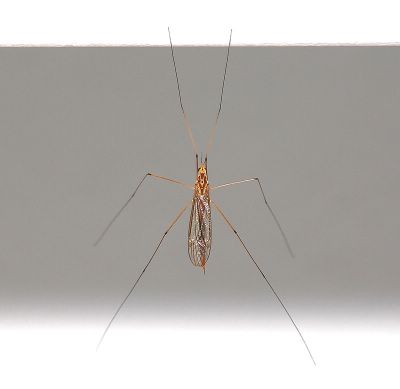
There are some creatures that have always been around. You cannot really say when you first laid eyes on them. You never really have that discovery moment. This particular fly must have been around the house during my infancy. Possibly making its bouncy flight just above my crib before night night time. The crane fly has always been called the Gallynipper in our family but I do not why. It is one of God’s creations that bring a little comic relief with its presence. Those outrageously long legs connected to that pitifully small body, and those little wings that seem to barely keep the nipper aloft.
This particular one caught my attention because it was hanging in a way I had never seen, suspended by the two foremost legs while the other legs gently dangled down. It never ceases to amaze me. Just when you think you know something so well it does something you would never anticipate.
Common Name: Crane fly
Scientific Name: Varies
Order: Diptera
Description: Although some people think these flies look like Texas-sized mosquitoes, and they have also wrongly been called "mosquito hawks." Crane flies are large tan-colored fragile flies with long legs. Adults and larvae do not feed on mosquitoes. Larval forms of crane flies are grey-brown cylindrical larvae which may bear fleshy lobes on the (posterior) end. Occasionally, the segments towards the end of the body can be greatly expanded.
There are many species of these flies that occur in Texas. The term "mosquito hawk" generally refers to dragonflies (Odonata), but could also refer to the large true mosquito species in the genus, Toxorhynchites (Diptera), which have larval stages that are predaceous on mosquito larvae.
Life Cycle: Larvae are often encountered under layers of decomposing leaves in wet locations such as ditch banks in December and January. Adults emerge in February and March.
Habitat and Food Source(s): Larvae have chewing mouthparts. Crane fly larvae feed primarily on decomposing organic matter. Adults do not feed. They commonly occur in moist environments such as woodlands, streams and flood plains although some species inhabit open fields, dry rangeland and even desert environments. In compost piles, they often occur on the soil surface below the pile of decaying vegetation. Some species have been reported to feed on roots of forage crops, turf grasses and seedling field crops. Usually their presence causes little concern because they are assisting in the process of decomposition. Larvae have not been reported to feed on vegetable transplants or garden plants in Texas. Adults have long slender legs which are easily broken and may be missing in some specimens.
Pest Status: Large numbers of adult crane flies can be a nuisance indoors; medically harmless.

The Gallynipper, aka Gallynapper in Oklahoma. It's nice to know one of God's creations has not only been noticed but photographed. There's one resting on my kitchen screen as I type. I'm in SE Kansas.
ReplyDeleteThey sure are wide ranging critters!
ReplyDelete